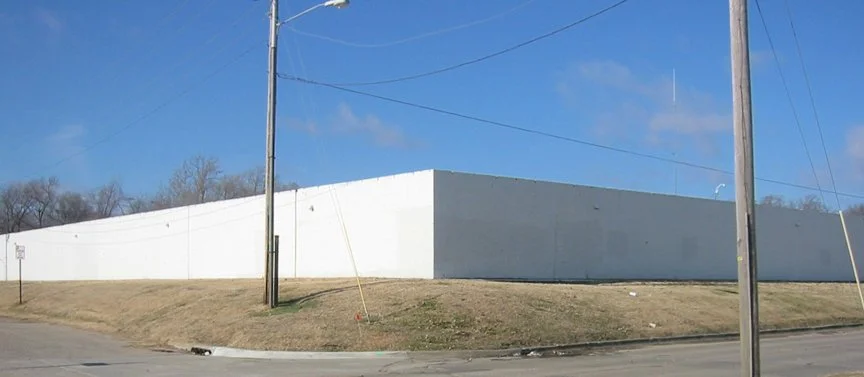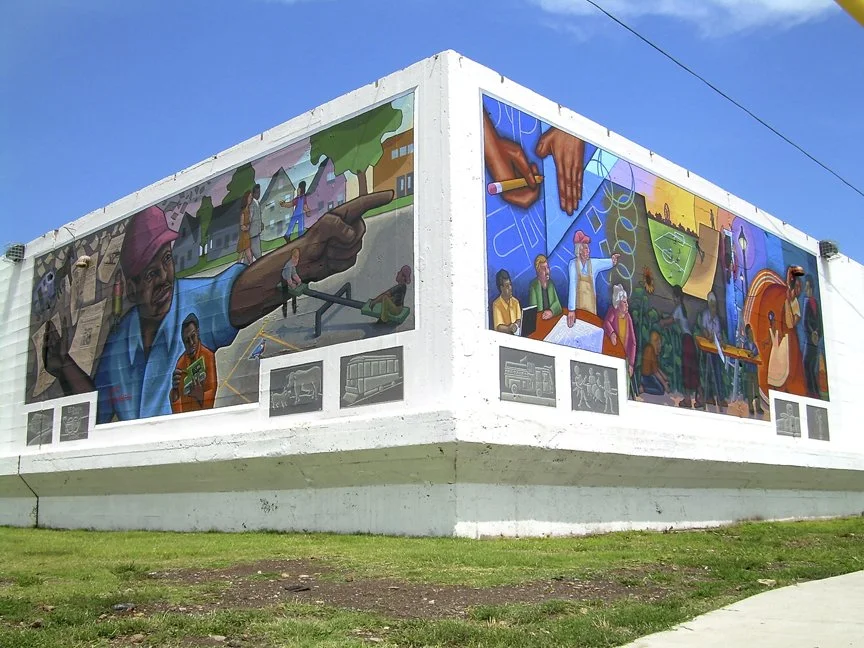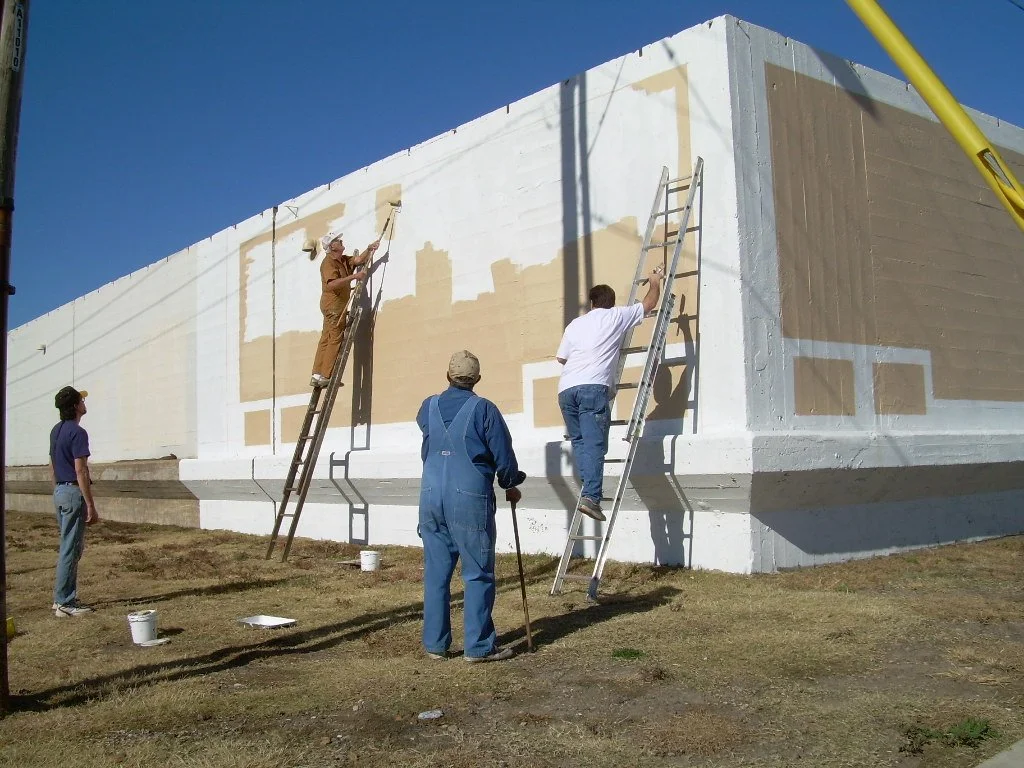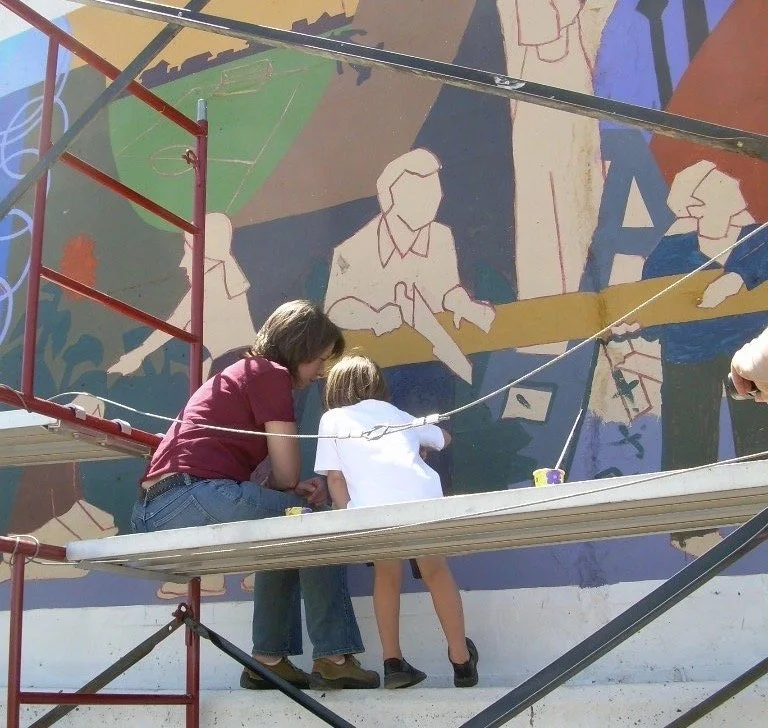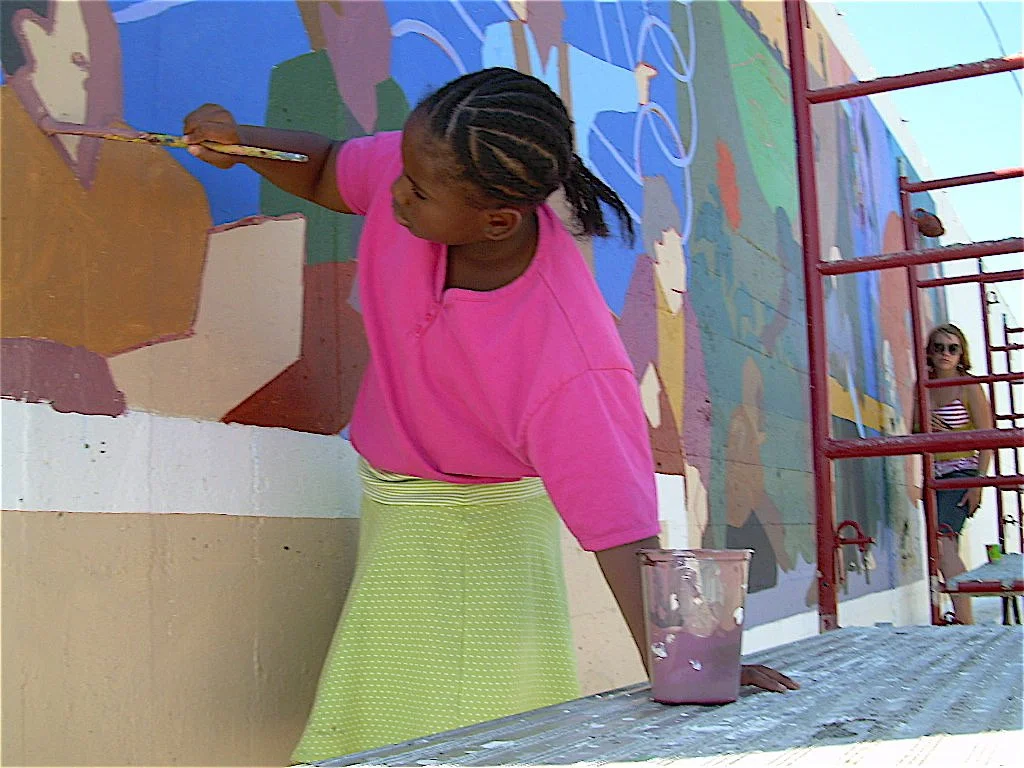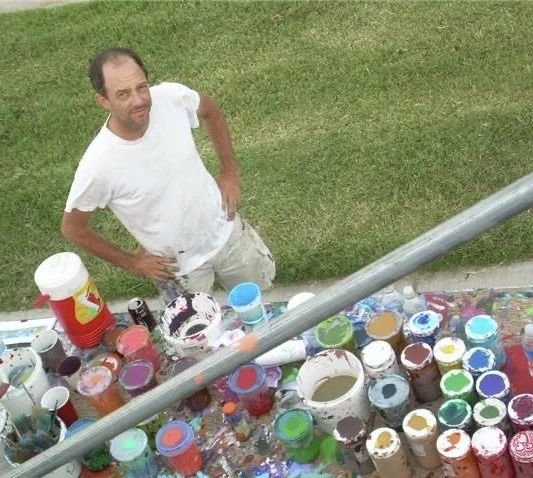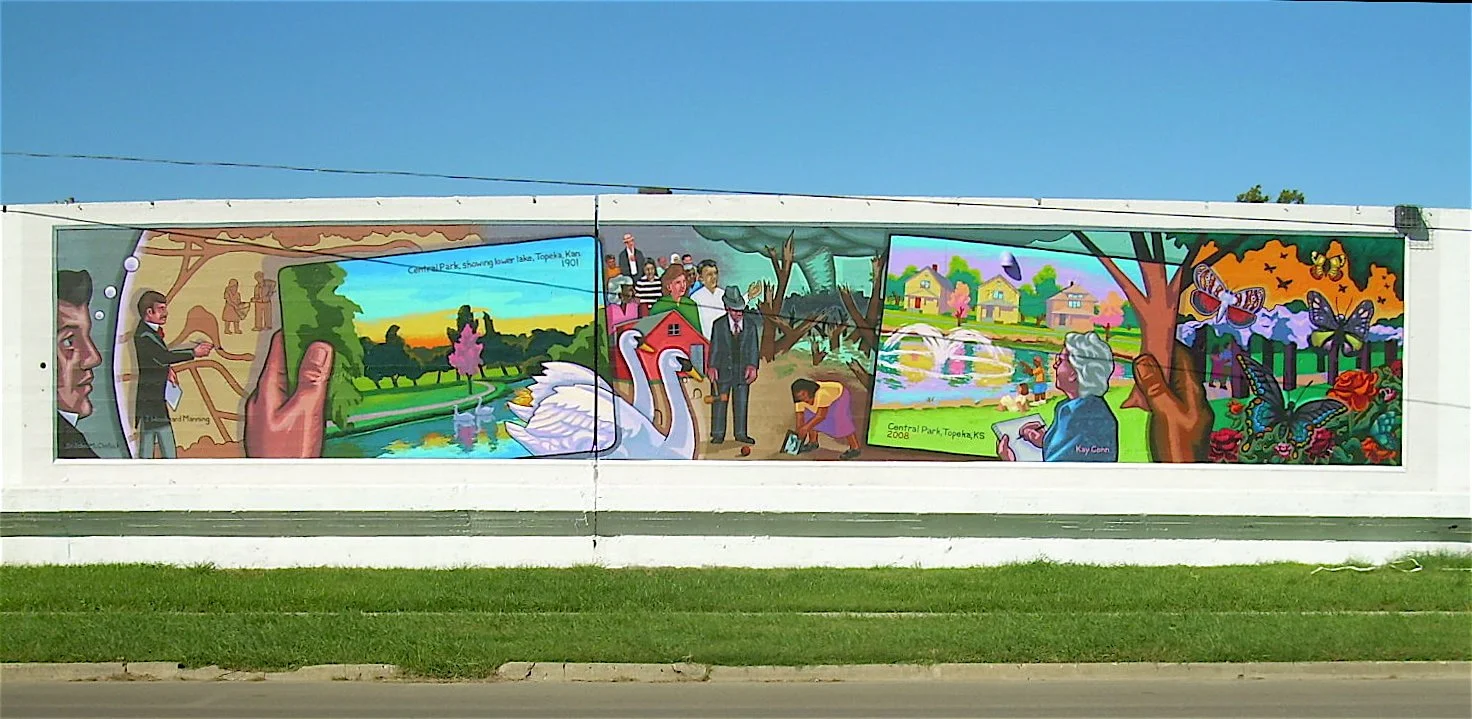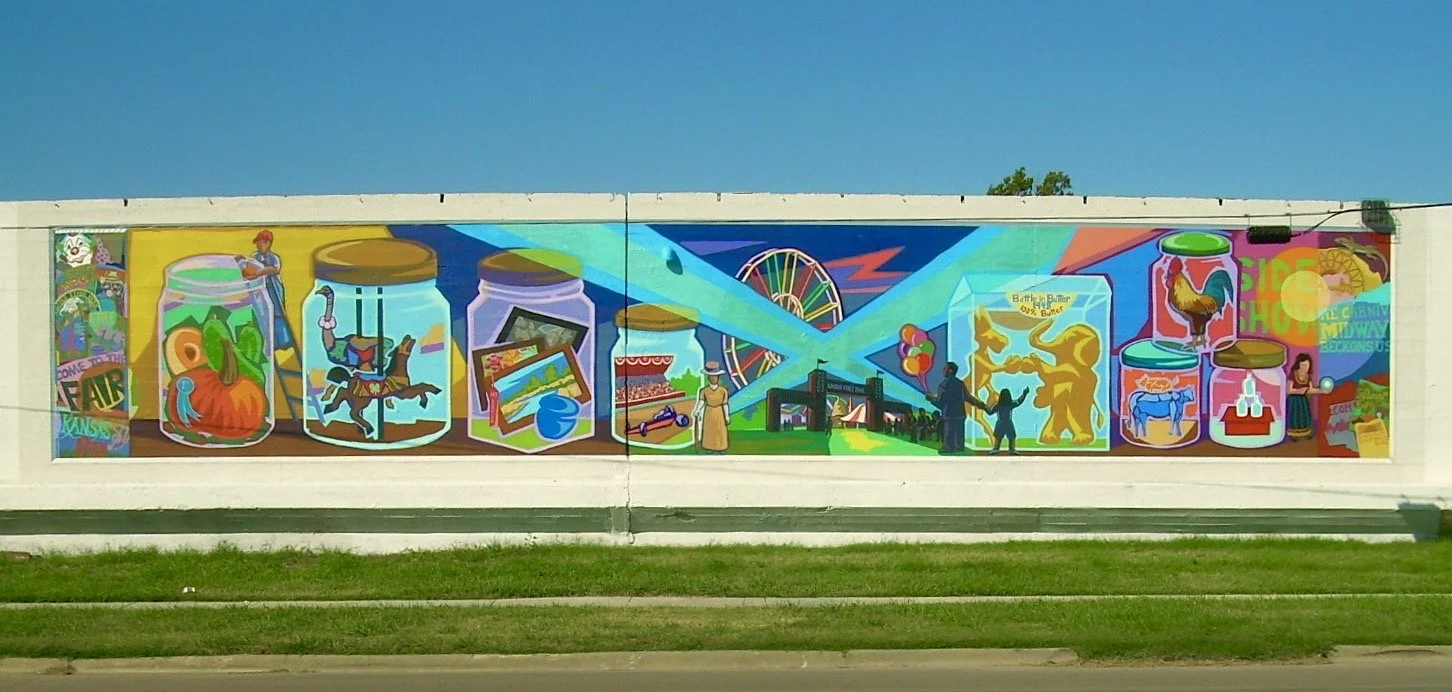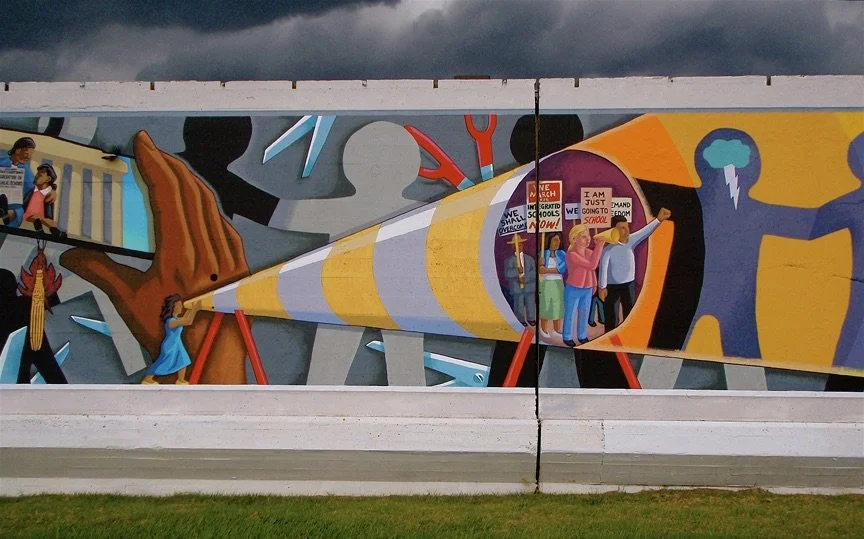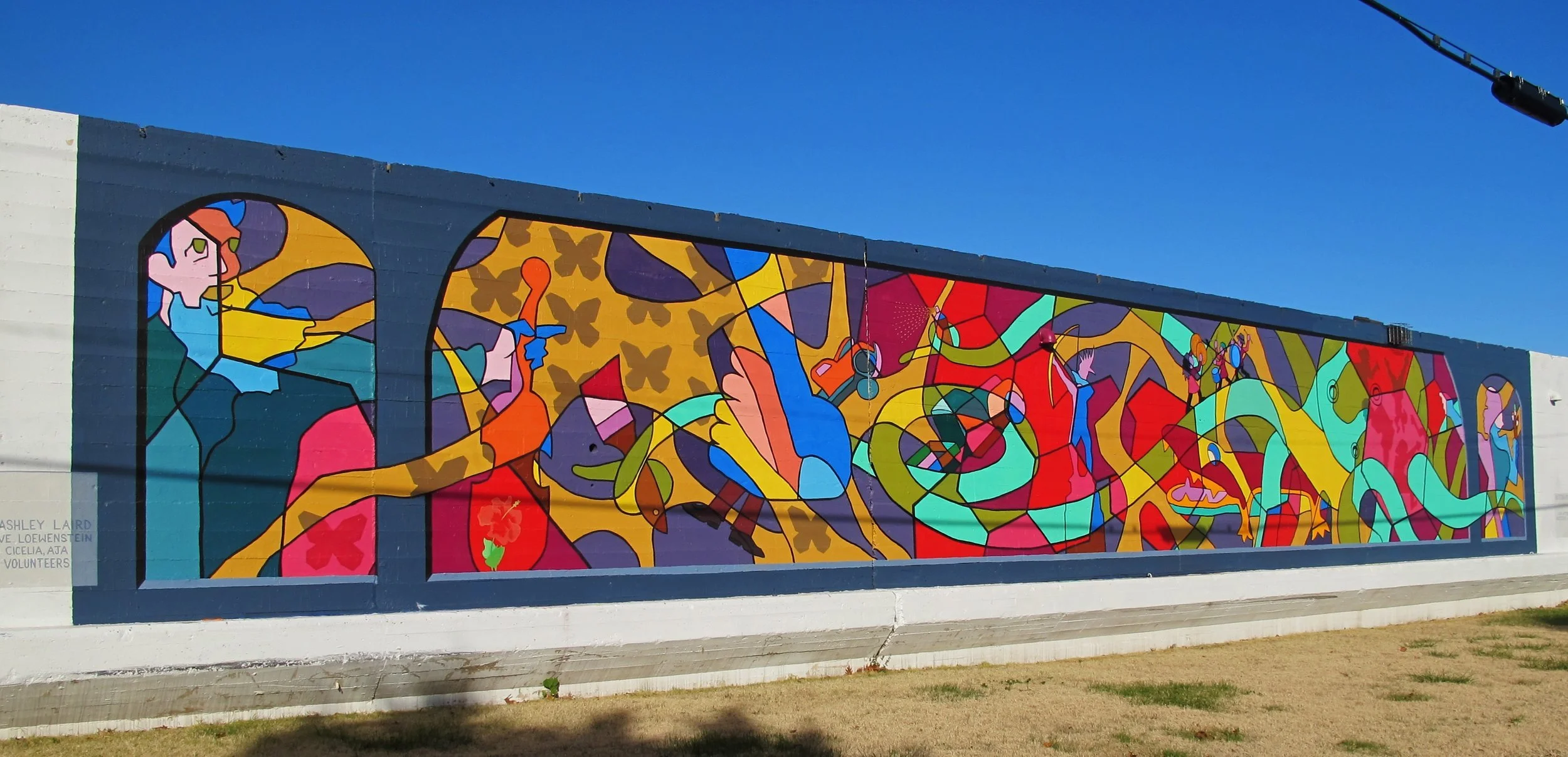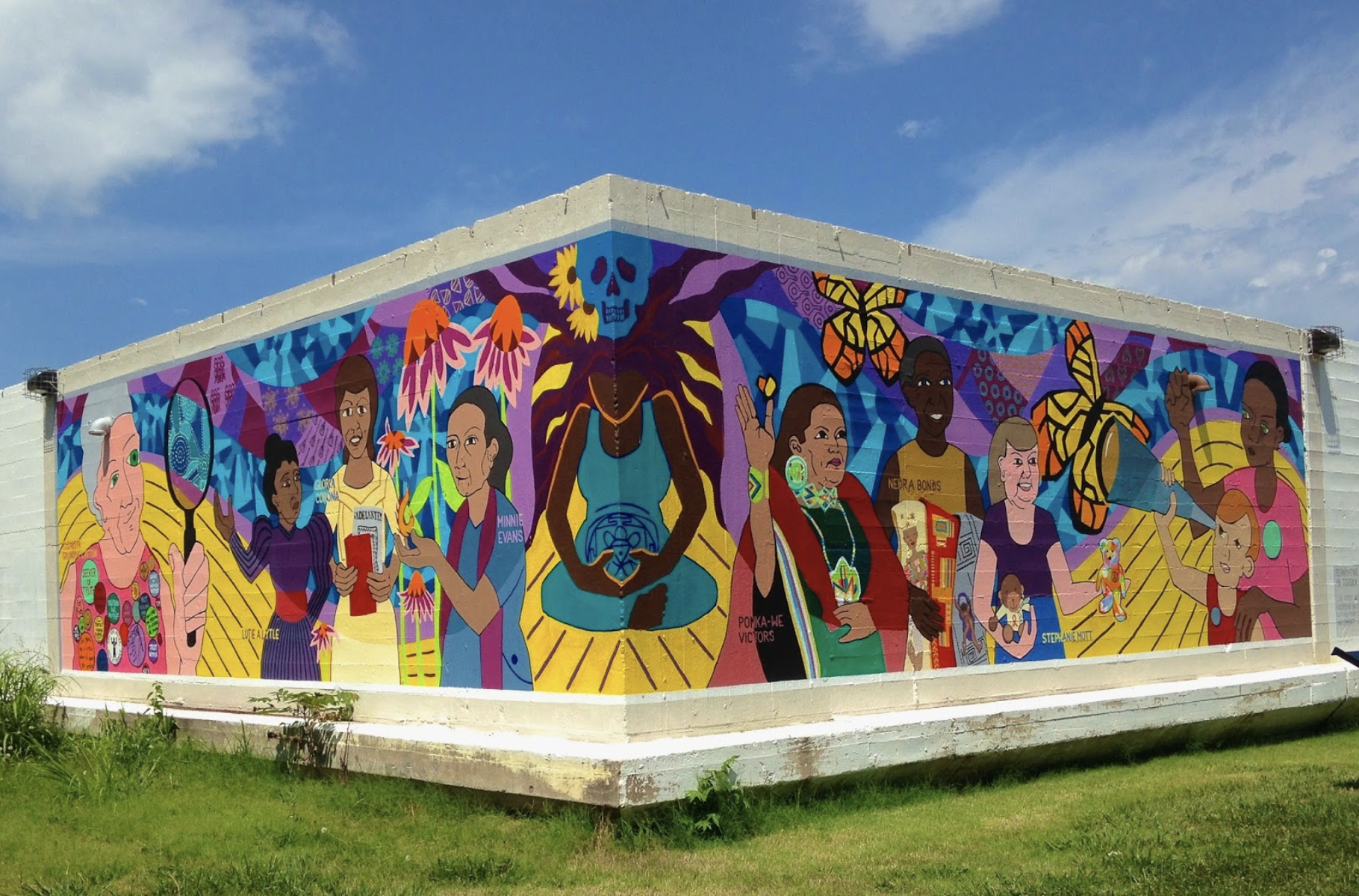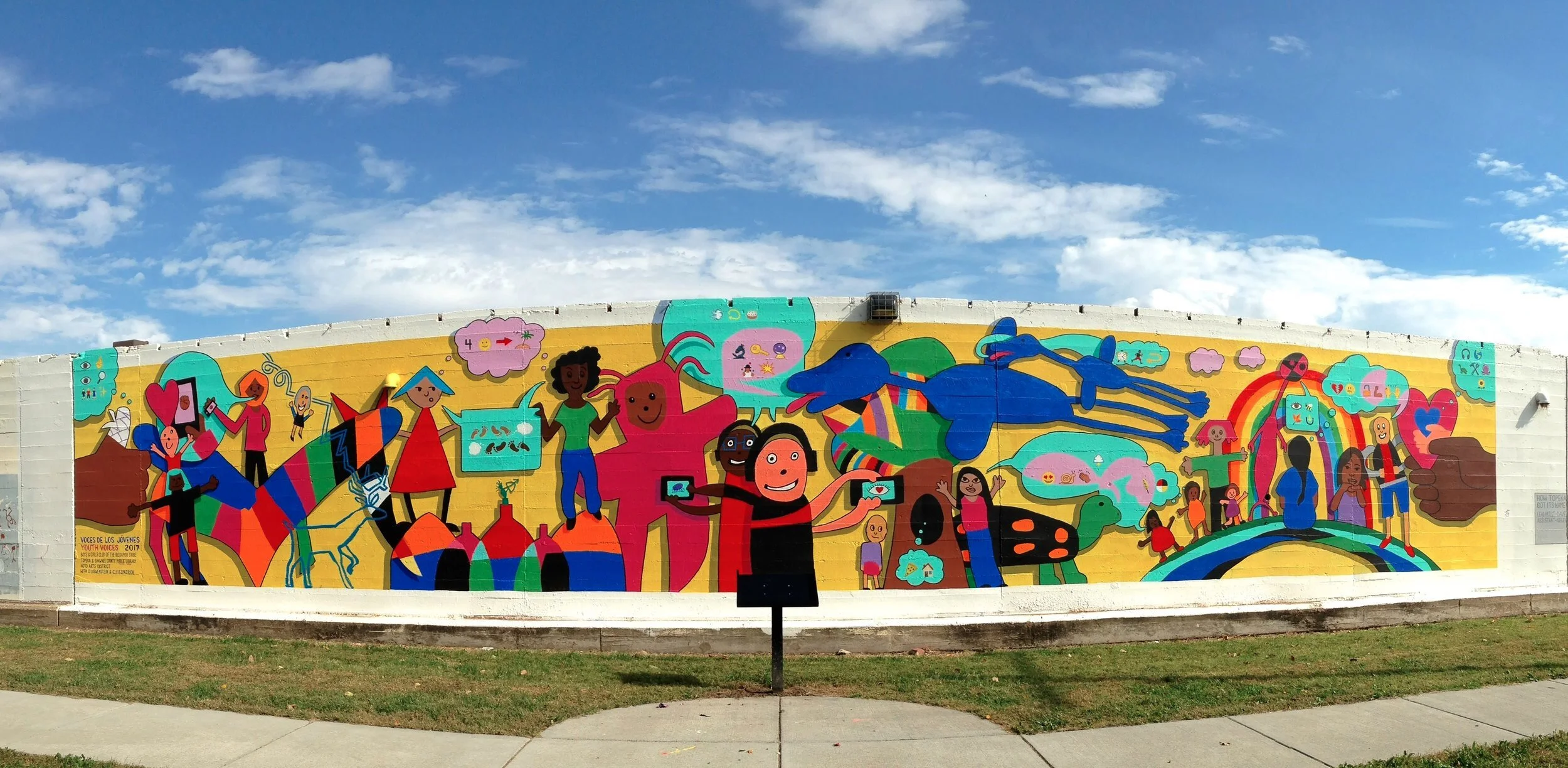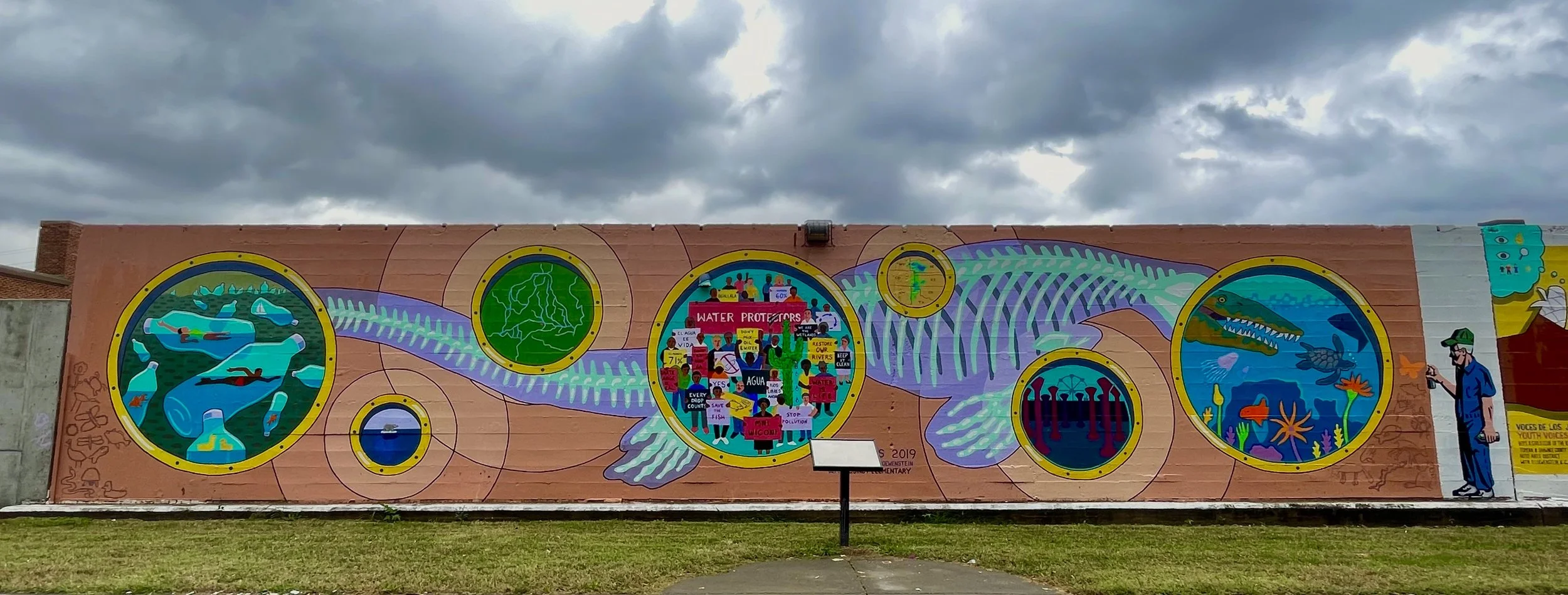The Great Mural Wall of Topeka
Topeka, Kansas 2007 - 2019
A Project of the Chesney Park Neighborhood Improvement Association with leadership and encouragement from Frank Hoge and Tom Benaka
The Great Mural Wall of Topeka was a collaborative project of the Chesney Park Neighborhood NIA and the City of Topeka Water Department. Inspired by the Great Wall of Los Angeles led by artist Judy Baca and SPARC, the GMWT partnered with neighborhoods, schools and community groups to create murals that highlight People’s History and community aspirations.
Tribute to Grant Cushinberry
2007
Assisted by Camille Bachand. With help from the Chesney Park mural design team and many neighborhood volunteers
In this the first panel on the Great Mural Wall, lead artist Dave Loewenstein worked with community members to think about people and events that had had great positive impact on the neighborhood but perhaps were not widely known. Grant Cushinberry was the unanimous choice. Cushinberry was revered in Chesney Park for his humanitarianism , generosity and mentoring. He began the neighborhood associationand was known for fixing toys for kids out of his garage, mentoring young people, maintaining a community and other large-hearted activities. Cushinberry points directs viewers around the corner to the accompanying panel which envisions neighbors enacting their aspirations in projects that include a community garden and skateboard ramp. Loewenstein recounted taking an initial sketch of the mural to Cushinberry, explaining that since he had contributed so much to the health and unique energy of Chesney Park, it only made sense to feature his large, inspiring presence at the center of the mural. Cushinberry's response when shown the rendering was a smile as he said, "It's about time." The neighborhood agreed.
A History of Central Park
2008
Assisted by KT Walsh. With help from Kay Conn and many community volunteers
In 1899, the land that would become Topeka’s Central Park was sold to the city by Dr. John McClintock (pictured on the far left) for one dollar. Esteemed landscape architect J. Woodward Manning (pictured next to McClintock) designed a public space inspired by his hero Frederic Law Olmsted (designer of New York’s Central Park) that brought nature into the city and was accessible to all citizens. Hands of a viewer who stands outside of the mural hold and compare postcards of the park - one on the left from 1901, the one on the right from 2008. The two postcards portray the evolution of Central Park, from its beginnings as the “gem in Topeka,” to the destruction of the 1966 tornado, to its subsequent revitalization. Longtime resident and local historian Kay Conn provided the historical record and photographs as research for the mural and she is included in the mural (right center with notebook) documenting the scene.
Preserving Memories of the Kansas Free Fair
2008
Assisted by Julie Ferriera and KT Walsh. With help from Charlotte Noland and many community volunteers
Many elders in Topeka still remember the grandeur and excitement of the Kansas Free Fair, which took place in the first half of the 20th century on the grounds of what is now the Expo Centre – located across the street from the mural itself. Vestiges of it still exist in the gate at the corner of 17th & Topeka Blvd. Preserving those memories in giant mason jars was the clever theme for this panel on the Great Mural Wall. Within the jars we see the 1947 “Battle in Butter” which references the presidential race that pitted Democrat Harry S. Truman vs. Republican Thomas Dewey along with more traditional fare. During the planning of the Free Fair panel, local resident Charlotte Noland shared her memories as a young woman attending the fair and even acting in the 1954 Kansas Centennial pageant.
The Road From Brown v. Board
2009
Assisted by Marty Moreno’s Advanced Art Class from Topeka High School and KT Walsh
For this dynamic mural, Topeka High School students examined the legacy of the historic Brown v. Board decision, which outlawed racial segregation in public schools, and then considered solutions to confronting and overcoming stereotypes and prejudice in their own lives today. Students developed the idea of the road as a metaphor to look back and forward through history. In the rear view mirror we see one of the Brown v. Board plaintiffs on the steps of U.S. Supreme Court. Ahead on the road, students (modeled by design team members) turn the page of history that had been dominated by the notion of separate but equal. Paper cutouts unfolding across the wall represent stereotypes. One student with the aid of another is able to break out of the stereotype and become fully realized.
Puttin’ Down Roots in Elmhurst
2009
Lead Artist - KT Walsh Assisted by Ashley Laird, with help from many community volunteers
This whimsical mural celebrates the Elmhurst Neighborhood’s 100th anniversary, including many of the people and places that make it a vibrant and unique place. From the Topeka Shawnee County Public Library to the floating typewriter of the beloved columnist known as “Peggy of the Flint Hills,” the mural juxtaposes historical images with glimpses of current neighborhood goings on including local kids at play and wildlife.
Ad Terra Per Agilitas
2010
Lead Artist - KT Walsh Assisted by Ashley Laird with the help of Chords and Oil and many community volunteers
The Latin title translates into roughly “Of the earth with agility.” At a time when the Kansas Legislature was considering the removal of protections for many endangered species in the state, this mural highlights animals in need of our care. Included are the lesser prairie chicken, red belly snake, flying squirrel, and ornate box turtle among others. The mural was created with the Topeka arts collaborative Chords and Oil, and reflects the desire of artists and neighborhood residents to connect with the local environment. It addresses the impact we have on the places we inhabit by showcasing threatened species of northeast Kansas, framed by sources of pollution on one end, and the road to a more sustainable future on the other.
Reanimating the Arts in Topeka
2011
Lead Artist - Ashley Laird Assisted by Cicelia Ross Gotta and Dave Loewenstein, with help from Chords and Oil and many community volunteers
Following the dismantling of the Kansas Arts Commission in 2010, artist Ashley Laird and a team of community volunteers designed and painted this energized homage to Topeka’s creative spirit. With both recognizable and lesser-known references to Topeka artists and artworks, this mural celebrates the heritage and continued vitality of Topeka’s creative community. Animating the beloved playground sculptures in Gage Park and Truck-Henge, Topeka drummers, John Brown gestures from the left while a figure from Aaron Douglass’ mural gestures from the right The design also explores the interweaving of molecular forces and synapses as a metaphor for the contagious spreading of art. As Topeka reflects on its rich history and continues to cultivate art, the desire to create becomes more activated and alive.
Kansas Women Work for Justice
2014
Lead Artist - Ashley Laird Assisted by Catherine Hart with the help of many community volunteers
Here on the corner of 20th & Fillmore, this mural depicts three interconnected generations of Kansas women who have all worked tirelessly for social justice. On the left, the grandmother is symbolized by the artist Grandma Layton from Wellsville. She is the giver of wisdom, keeper of history and close observer of the world around her. In the center, at the corner, is a symbolic representation of a Kansas mother. Her energy connects the elders to the youth. At the right, her children (who are participants in our project from the Chesney Park Neighborhood) are challenged by contemporary struggles and strive (with a look back at history through a telescope) to create the more equitable and just world that their parents and grandparents only dreamed of. A ribbon of knowledge and heritage binds these figures together. Within it we see women who have inspired us like, Wellsville artist, Elizabeth ‘Grandma’ Layton, Lutie A. Lytle, Potawatomi Chairwoman Minnie Evans, Gloria Corona, State Representative Ponka-We Victors, artist Nedra Bonds and civil rights activist Stephanie Mott.
How Topeka (Dópik’è) Got its Name
2015
Assisted by Ashley Russell, with help from Jimm Goodtracks, Pauline Sharp and many community volunteers
How did Topeka get its name? This is the central question and theme of this panel on the Great Mural Wall. The design focuses on stories, some true and others more like urban folklore, that illustrate what the word Topeka means and how it was chosen for what we now know as our state capital. At the center of the mural, An Ioway Tribe elder describes to her grandson and great grand daughter the story of Topeka (Dópik’è). She gestures to the place along the Kansas River where many tribes dug for what are commonly known as prairie potatoes, or in Latin Psoralea esculenta. Encircling them is a woven braid of the ‘potatoes’ that illuminate the sky. To the right, we see students watching a film in class that perpetuates the common myth that Topeka refers to an Indian looking down to find a hole in his shoe and saying, “Toe peek ah.” And then in a separate panel further to the right, signs are stacked up on signposts indicating the many places and peoples associated with Topeka and where they are now. To the left of center, colonists and explorers roll into the scene laying down the gridwork of progress and muting the heritage of traditional knowledge symbolized by the wild prairie potato. The progress is challenged by a herd of bison that block their path. (we know how that story ended). Finally on the far left, the Psoralea esculenta, Do, or Tipsin is depicted in its full glory with the many names it is known by encircling it.
Voces del los Jóvenes / Youth Voices
2017
Collaboration with youth from the Boys and Girls Club of the Kickapoo Tribe and the Topeka & Shawnee County Library Teen Zone
In the language of pictures, from self-portraits to emojis, Topeka area youth speak their truth in this fanciful mural. Working with artist Dave Loewenstein, youth from the Boys and Girls Club of the Kickapoo Tribe, Topeka & Shawnee County Library Teen Zone, and First Friday in the NOTO Arts District responded to the prompt: What’s the best and worst thing about being a kid? Their answers portray a coming together of fantasy and reality, suggesting that grown-ups have a lot to learn from their younger counterparts.
Waterways
2019
Collaboration with students from Quincy Elementary School
In this panel, seven portholes share different aspects of our relationship to water, from the effects of climate change, pollution and inequitable access to our regional watershed, Ogalala aquifer and Topeka water reservoir. Lurking behind these portholes is the massive skeleton of a Cretaceous period reptile known as the Mosasaur that once roamed the inland ocean where Kansas is today. Lead artist Dave Loewenstein worked with students at Quincy Elementary School and employees at Topeka Water Services to develop the design. And, Frank Hoge (Topeka’s oldest graffiti artist and long-time co-coordintator of the Great Mural Wall) appears spray painting his well-known butterfly tag on the far right.

